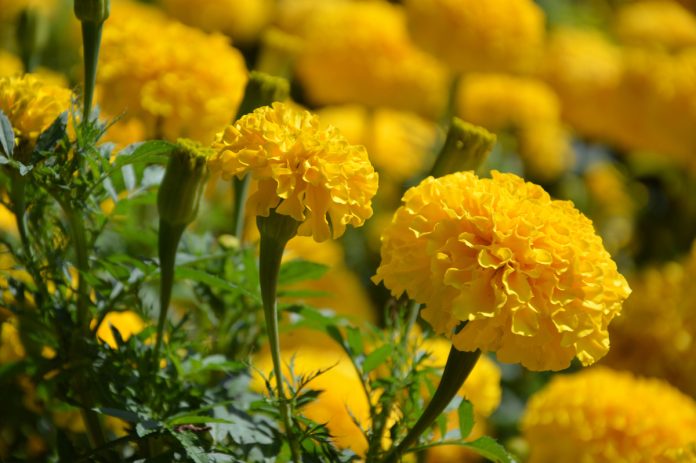Are you looking for a beautiful and low-maintenance flower to add to your garden this summer? Look no further than marigolds. These popular annuals are known for their bright, cheerful blooms and easy-care habits.
Types of Marigolds
There are several different types of marigolds to choose from, including:
1. African marigolds: These are the largest of the marigold types, with blooms that can reach up to 5 inches in diameter. They come in shades of yellow, orange, and red.
2. French marigolds: Smaller than African marigolds, French marigolds have dainty flowers in shades of yellow, orange, and bicolor.
3. Signet marigolds: These small marigolds grow to about 12 inches tall and have delicate, edible flowers in shades of yellow, orange, and red, and are perfect for container gardens.
Planting Marigolds
Marigolds prefer full sun, but can also tolerate some shade. When planting, space them at least 8-12 inches apart.
Deadheading Marigolds
Deadheading is the process of removing spent blooms from the plant. This encourages the marigold to keep producing more flowers. Simply snip off the dead blooms just above the next set of leaves.
Caring for Marigolds in Frost
While marigolds are relatively hardy, they are still susceptible to frost damage. If a frost is expected, cover your marigolds with a light sheet or blanket to protect them from the cold.
Companion Planting with Marigolds
Marigolds are great companion plants for vegetable gardens because they have a natural pest-repellent quality. Plant them near tomatoes, peppers, and other vegetables to help keep pests away.
Saving Marigold Seeds
To save marigold seeds, wait until the flower head has completely dried out and turned brown. Then, remove the dead flower head from the stem and gently shake it over a tray or sheet of paper to release the seeds. Separate the seeds from any plant debris and allow them to dry completely before storing.
Shelf Life of Marigold Seeds
When stored in the proper conditions, marigold seeds can remain viable for up to three years. However, to increase the likelihood of successful germination, it’s best to use the seeds within one year of harvesting.
Storage Conditions
Like all seeds, marigold seeds should be stored in cool, dry conditions to help prolong their shelf life. Place the seeds in an airtight container, like a ziplock bag or glass jar, and store them in a cool, dry location, like a pantry or basement. Avoid storing seeds in areas of the house that may experience temperature fluctuations, like the attic or garage.
Labeling Your Seed Container
It’s important to label your marigold seed container with the date harvested, as well as the variety of marigold. This will help you keep track of when the seeds were collected and ensure that you’re using fresh, viable seeds when planting.
Saving marigold seeds is a great way to continue growing your favorite flowers year after year. By drying the seeds thoroughly and storing them properly in cool, dry conditions, you can help ensure their viability for up to three years.
Marigolds as a Pest and Animal Deterrent
Here are a few ways marigolds can help keep pests and animals away:
1. Insect Repellent: Marigolds contain a chemical called pyrethrum, which is often used in insect repellents. Planting marigolds around your vegetable garden or flowers bed can help repel unwanted insects like mosquitoes, aphids, and even nematodes.
2. Deer Deterrent: Deer love to munch on a variety of plants and flowers, but they tend to steer clear of marigolds. Planting marigolds around your garden and flower beds can help deter deer from nibbling on your favorite plants.
3. Rabbit Repellent: Just like deer, rabbits have a taste for many garden plants. However, they don’t seem to be fans of marigolds. Planting marigolds around your garden can help repel rabbits and protect your plants from becoming a snack.
4. Rodent Repellent: Marigolds emit a strong scent that rodents like mice and rats find unpleasant. Planting them around your garden and the perimeter of your home can help deter rodents from making a home in your yard.
Whether you’re trying to keep insects, deer, rabbits or rodents at bay, marigolds can provide a non-toxic and effective solution.
Marigold Facts
Here are some interesting facts about marigolds:
1. Marigolds belong to the family of plants called Asteraceae.
2. They are native to Central America and Mexico but are now grown all over the world.
3. They come in a variety of colors including orange, yellow, red, and even bi-colored.
4. The name “marigold” comes from the Virgin Mary because the flower was often used in early Catholic ceremonies.
5. Marigolds have been used for medicinal purposes for centuries, treating everything from skin irritation to fever.
6. In Hinduism, marigolds are considered sacred flowers and are used in offerings and decorations during religious festivals.
7. They are often used as a companion plant in gardens because they repel certain insects and animals that might damage other plants.
8. Marigolds are easy to grow from seeds and are often used in container gardens or as border plants.
9. French marigolds (Tagetes patula) and African marigolds (Tagetes erecta) are the two most common types of marigolds.
10. Marigolds are popular in Day of the Dead celebrations in Mexico, where they are used to create colorful altars and offerings to the deceased.
Marigolds are a wonderful addition to any summer garden. With their bright colors, easy care, and beneficial qualities, they are sure to bring joy to your outdoor space.
The Author:
Pioneerthinking.com – Ingredients for a Simple Life.
Photo. Peggy Choucair
